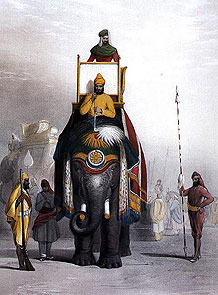
The Princely State of Patiala.

Under
British PATIALA was the most important Sikh
state.
The ruling families of Patiala, Nabha, Jind, Faridkot, Kaithal and Malaud
all claim to be descended from the Raja of Jaisalamer. Phool the founder of this
family along with his brother Sandaali became orphans in 1618, and both were taken
under the wing of their uncle. They both visited Guru Har Rai as youngsters along
with their uncle, it is said that their uncle told them to rap their bellies to
indicate to the Guru the poverty and hunger they were enduring. The Guru blessed
Phool and is said to have told him that he would make a king.
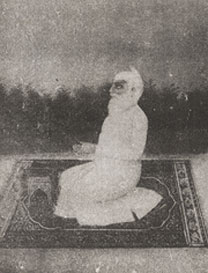
Baba Phool - the elder of PhoolVansh
Phool set up his own
village and was often in conflict with local chiefs. This enraged the Governor
of Sirhind who summoned him and put him behind bars. Phool died in 1652. He had
6 sons, of whom Rama emerged from this group as the most eminent. The Governor
of Sirhind appointed Rama to the post of Chaudhari. Rama was killed at Maler-Kotla
in 1714. He was succeeded by his son, Ala Singh.
Ala Singh assumed the leadership
in 1714 when Banda Bahadur was engaged in the fierce battle against the Mughals.
A man with vision and courage, Ala Singh carved out an independent principality
from a petty Zamindari of 30 villages. Under his successors, it expanded into
a big state, touching the Shivaliks in north, Rajasthan in the South and upper
courses of the Jamuna and Sutlej while confronting the most trying and challenging
circumstances.
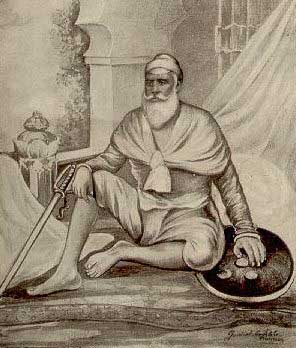
Maharaja. Ala Singh (1714-1765)
Sardar Ala Singh joined the Sikh fold in 1735 at the hands of Nawab Kapur Singh. He joined the Sikh forces and gained considerably from this in the terms of wealth and territory. In 1752, a General of Ala Singh, Sardar Gurbaksh Singh Kaleka won possession of eighty-four villages, one of which was Patiala. The Afghan Ahmad Shah Abdali conferred the title of Maharajah on Ala Singh during the formers eighth invasion between 1764 & 1765. The territory of Patiala continued to grow right up to the death of Maharajah Ala Singh on August 22nd 1765. He was succeeded by his only legitimate son, Amar Singh.
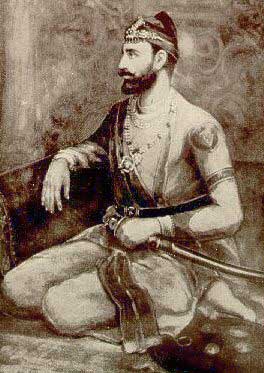
Maharaja Amar Singh (1765---1781)
Amar Singh continued to use other Sikh leaders to further his aims. He continued to extend his territory. In 1767 during Abdali's 9th invasion of India, Amar Singh paid a sum of 2 lakh rupees to set thirty thousand Indians captured by Abdali as slaves free. For this benevolent act he was given the name of Bandi Chhor (Liberator of the slaves). (Information taken with courtesy of http://www.maharaja.freeserve.co.uk/patiala.html )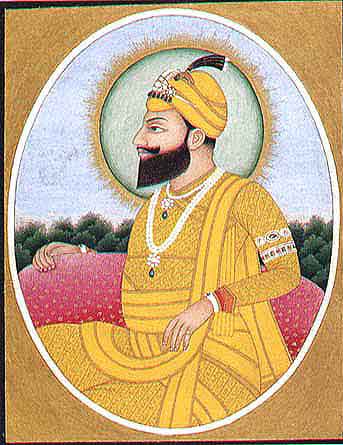
Maharaja Amar Singh
Maharajah Amar Singh died in February 1781. His son, Sahib Singh succeeded him at the tender age of seven. Sahib Singh was a very weak figure and was outdone by his sister Sahib Kaur on the battlefields. Maharajah Sahib Singh died on March 26th 1813. His eldest son, Karam Singh succeeded him.
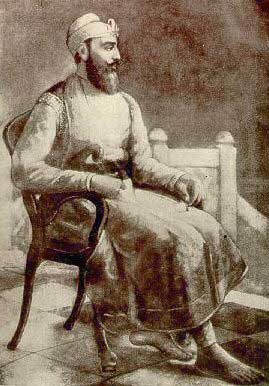
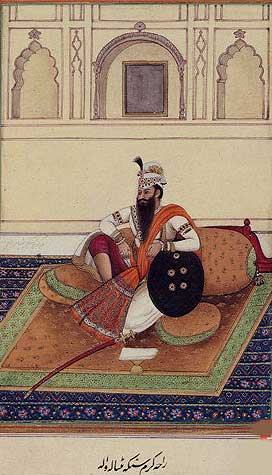
Maharaja Karam Singh
Karam Singh helped the British during the war against the Gurkhas in 1814 and during the first Sikh War in 1845. He died on December 23rd 1845 and was succeeded by his son Narinder Singh.
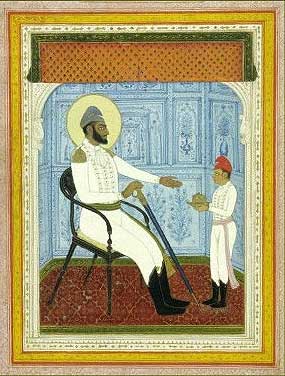
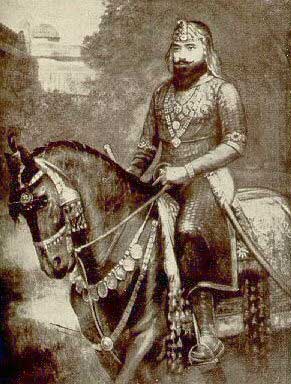
Maharaja NARENDRA SINGH 1845/1862, born 26th November 1823, married 7 wives, including Maharani Karam Kaur, daughter of Sardar Ghulab Singh Buria, and had issue, 1 son Mahendra Singh and 3 daughters. He died 13th November 1862.
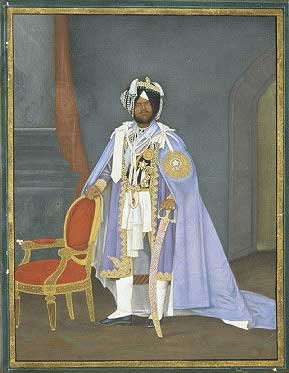
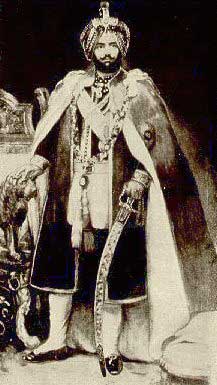
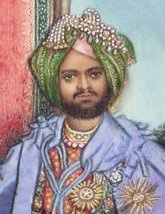
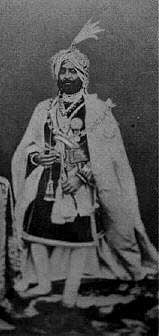
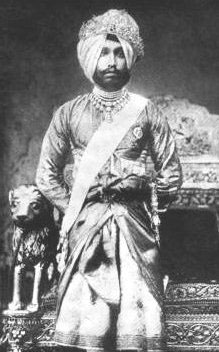
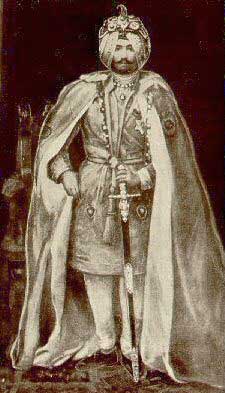
HH Maharaja RAJENDRA SINGH Bahadur 1876/1900, born 25th May 1872, G.C.S.I., married (b) 13th April 1893, Florence Gertrude Bryan, christened 20th December 1873, daughter of Charles and Minnie Bryan, died about 1896, and had issue. He died 8th November 1900.
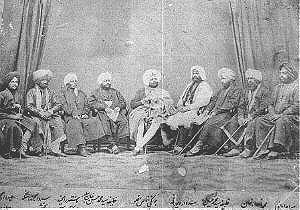
Maharaja Rajendra Singh with his courtiers
The great grandson of Narinder Singh, Maharajah Bhupinder Singh was one of the best-known Indian Maharajahs during the 20th century. He ascended the throne at the age of eight in 1900.(Below) There are many stories about his extraordinary wealth and the unique class that made him distinct from all the other Indian Maharajahs. He was a regular visitor in Europe and would buy the contents of stores in minutes
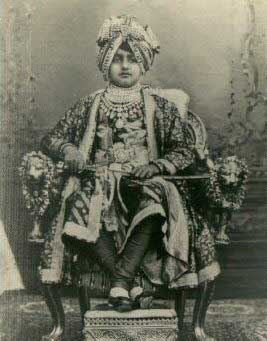
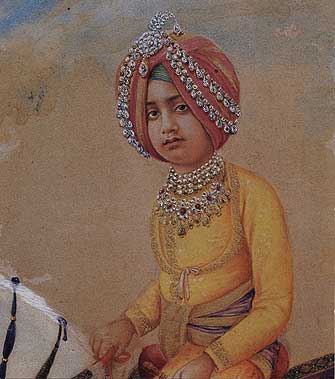
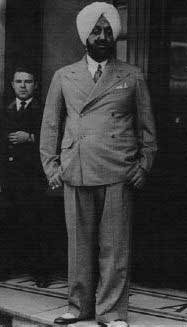
He was well known in London and he usually stayed at the Savoy where he would book the whole of the 2nd floor. He would be driven in a motorcade of 20 Rolls Royce cars. He died in 1938 and was succeeded by his son, Maharajah Sir Yadvinder Singh on March 23rd, 1938.
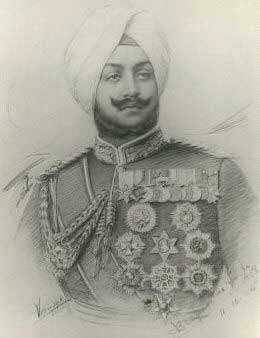
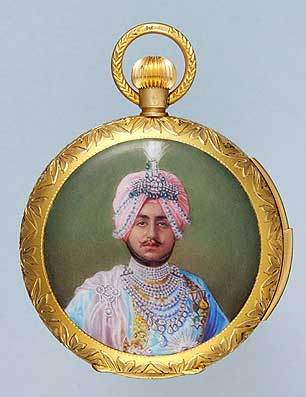

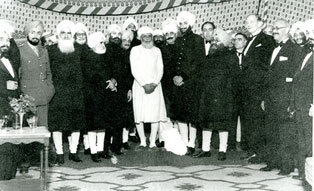
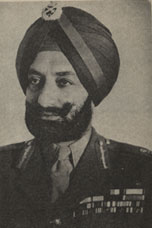
· Capt. HH Maharajadhiraj Shri AMARINDER SINGH (qv) {Present Maharaja)

PATIALA, a city of gardens and palaces, has a rich architectural and cultural heritage. The oldest part of Patiala is the walled city within which Quila Mubarak; the oldest fortified palace of the city, sits on a raised mound. Quila Mubarak forms the core around which the walled city developed.
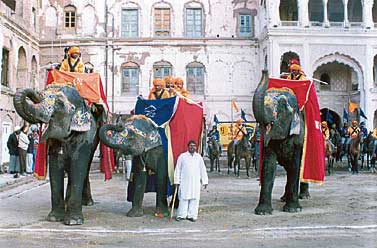
Elephants get ready for a procession in front of Qila Mubarak
In 1763
Baba Ala Singh laid the foundation of the Patiala fort known as Qila
Mubarak, around which the present city of Patiala is built. After the
third battle of Panipat in 1761 in which the Marathas were defeated, the writ
of the Afghans prevailed through out Punjab. It is at this stage that the rulers
of Patiala began to acquire ensigns of royalty. Ahmed Shah Abadali bestowed upon
Ala Singh furm and banner, after latter's death, his grandson Amar Singh succeeded
and received the title of Raja-I-Rajjan. He was also allowed to strike coins.
After forty years of ceaseless struggle with the Mughals, Afghans and Marathas
the borders of the Patiala state witnessed the trailing blaze of Ranjit Singh
in the North and the other of the British in the east. Bestowed with the grit
and instinct of survival, making right choice at right time the Raja of Patiala
entered in a treaty with the British against Ranjit Singh in 1808, thus becoming
collaborators in the ground empire building process by the British in the sub-continent
of India. The British treated the rulers of Patiala, such as Karam Singh, Narinder
Singh, Mahendra Singh, Rajinder Singh, Bhupinder Singh and Yadvindra Singh with
respect and dignity
It was Maharaja Bhupinder Singh (1900-1930) who gave the
Patiala State a Prominent place on the Political map of India and in the field
of international sports. Most of the buildings with very nice architectural designs
were constructed during his reign. His son Yadvindra Singh was among those Indian
princesses who readily came forward to sign the Instrument of accession, thus
facilitating the process of national integration. In recognition of his services,
he was appointed the Rajpramukh of the newly established state of PEPSU
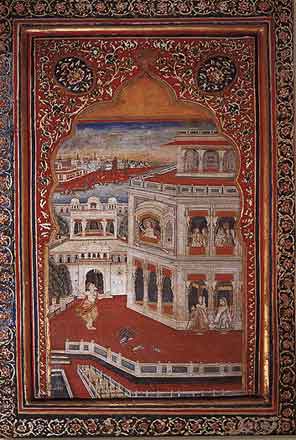

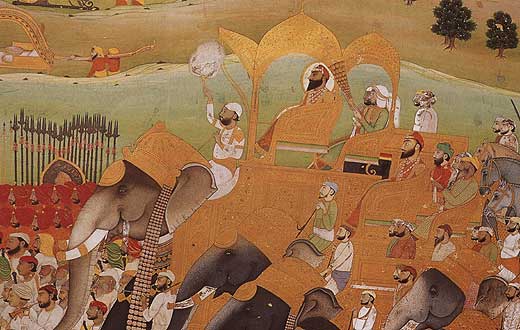
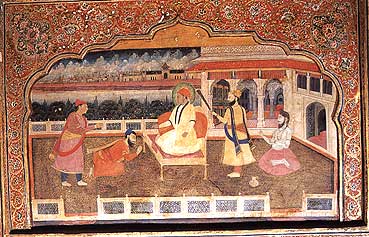
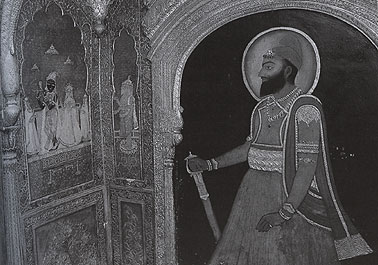
It has two portions, Qila Androon , the inner fort , Qila Mubarak the outer. The facade of gate of Qila Androon is decorated with geometrical and floral designs in lime plaster. There are two painted chambers depicting scenes from Hindu mythology and portraits of sikh Gurus in Patiala style . The complex has a unique underground sewerage system . An excellent museum of chandeliers ande famous weapons is located here.
Also worth- seeing are Motibagh palace which houses a museum and which, in addtion to beautifull collections of the arts and the artifacts also houses the word's greatest collection of medals, with Baradari gardens, Gurudwara Dukhiniwaran sahib, Temple Kali Devi, which on account of the rare murals on its walls , has been declared a national monument, Patiala is a centre of education, an emporium of consumer goods and is well-known for its royal cuisine and hospitality .
QUILA MUBARAK-MUSEUM
Contains rare cannons, swords,shields and maces , daggers of Guru Gobind Singh Ji , Sword of Nadar Shah etc. and rich collection of chandeliers from Europe.
The Earstwhile Patiala State named after its founder Ala Singh as Patti of Ala or Ala Singh's land in local language has a relatively brief history of about 230 years but a rich tradition in the fields of education sports and music .
Mohindra college (Below) was founded in 1870 and was the only college between Lahore and Delhi .

In the fields of sports the rulers of Patiala were themselves good sportsmen and patronised good sportsmen.In Polo and Cricket Patiala had recognition at International level.
Gamma the world champion in wrestling and Kesar Singh , Champion of India also belongs to Patiala.
After disintegration of Mughal Darbar
in 1857 the musicians took patronage in states like Patiala , Gwalior and thus
came up the Patiala Ghrana which still alive in its exponents like Barhe Gulam
Ali Khan now settled in Pakistan.
The Rulers of Patiala took keen interest
in the development of the State. Thus we today have :
The Mohindera College,
Rajindera Hospital.
The Netaji Subash Institute of Sports,
Gymkhana Cricket Stadium,
Hockey, Football Stadium, Polo Ground ,
A Score of Swimming Pools ,
Most of Professional Colleges and a University.
SHEESH MAHAL -
HISTORY
Sheesh
Mahal in old Moti Bagh is designed on the pattern of Shalimar Garden of Lahore
with terraces,fountains,channels and flower beds. It was built by Maharaja Narendera
Singh in 1847 A.D. at a cost of 5 lacs. The Sheesh Mahal Museum at Patiala has
great importance in the field of painting, sculptures, medals and decorative art
objects.
Maharaja Narendra singh was a patron of literature, music and fine
arts.There were many poets , scholars and historians in his court.He employed
many artists, who hailed from kangra and Rajasthan and expressed their talents
on the walls of by depicting vision on the poetiry if Keshav das, Surdas and Behari
lal in line and colour. Mythology,legends,raga-ragini, Nayak nayika and bara-masa
themes are also depicted on its walls.A special room known as sheesh mahal was
got constucted by maharaj displaying the skills of artists in the convex and coloured
mirrors.Some designs remind of the floral designs of jahangir's period.
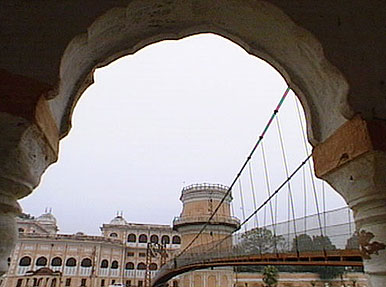
The Sheesh Mahal
A very fine set of miniature paintings
based on the themes of "Geet Govinda" in kangra style,based on jai deva's
poetry, is greatly commended by lovers of art.the kangra paintings also displayed
here,represent the best production of art dealing with krishna-lila.the marvelous
pieces of art reflect the highest professional skill and delicate taste of the
artists.who executed these works.These paintings stand out as a great legacies
of the middle of 19th century (1845 A.D).This art of paintings was patronised
by RAJA NIHAL SINGH OF KAPURTHALA.
In addition to the miniature paintings
of Kangra,there are also on view Rajasthani paintings of Jaipur school which flourished
side by side with mughal paintings.the chief centre were at Jaipur,Bikaner,Bundi,Mewar
and Kishangarh.The paintings displayed here are related to Raga-Mala which also
give visual meaning to the paintings.
The ivory work which started from
the earliest times and continued upto the begining of the twentieth century now
have become very rare.Lahore, amritsar and Patiala were famous ivory carving centres
in Punjab.There are very fine specimens of ivory work displayed in the galleres,
which include chessmen, horse rider ,beautifully carved tusks and a fine perforated
ivory piece with carved deities inside.
visit Patiala online http://www.patiala.org
DUKHNIVARAN SAHIB
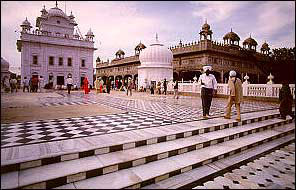
Gurdwara Dukh Nivaran Sahib is located in Patiala City, less than a kilometer from the Patiala railway station. The Gurdwara's construction was started in the year 1930 and was completed twelve years later in the year 1942. It is said that Guru Teg Bahadur ji, the ninth Guru visited this place at the request of the villagers of Lehal-now a part of the Patiala city-during his stay at Saifabad, now Bahadurgarh. A small shrine commemorating the Guru's visit existed here but when the proposal to construct the present Gurdwara was mooted in the year 1930, what remained at the spot was an old banyan tree and a well. A large sarovar also forms a part of the Gurdwara complex where the devotees invariably bathe whenever they visit the Gurdwara.
MOTI BAGH SAHIB
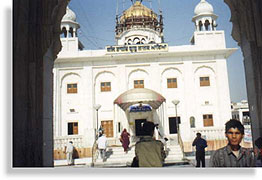
Gurdwara Moti Bagh is associated with the visit of Guru Gobind Singh ji to help Bahadur Shah Zafar succeed Aurangzeb when the latter suddenly died in the south as a desperate, disillusioned and frustrated man. Guru Gobind Singh ji along with an wonderful band of warriors had camped in a garden owned by an ardent follower of the Guru, Moti Ram. Hence this splendid Gurdwara is known as Gurdwara Moti Bagh.
BAHADURGARH
FORT :
6kms. from Patiala town on Patiala-chandigarh road, it was
originally built by Nawab saif khan in 1658 A.D. and rebuilt in 1837A.D. by Maharaja
Karam Singh.The constuction was completed in eight years and rupees ten lakhs
were spent on it.The circumference of the fort is around 2 km.Maharaj Karam Singh
gave the fort its present name to sacred memory of Guru Teg Bahadur who visited
this place while on his way to Delhi durin the reign of Emperor Aurangzeb.
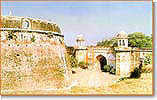
There
is a Gurudwara dedicated to Guru Teg Bahadur Sahib, inside the fort. There is
also a mosque built by Saif Khan in about 1668.The tomb of Saif Khan is about
three hundered yards from the fort.A fair known as mela roza Sharit Nawab Saif
Ali is held here during the months of June and January every year.
There is
also a historical Gurudwara known as Sri Gurudwara Sahib Patshai Nauvin built
in the sacred memory of Guru Teg Bahdur who stayed here for three months and nine
days before going to Delhi for martyrdom.Saif Ali Khan used to meet guru at this
place.This gurudwara is being managed by Shiromini Prabhandak Committee.A large
number of people visit this gurudwara on the occasion of Baisakhi every year.
Apart from the rich historical background,Bahdurgarh is now making rapid progress
in the field of industry also. Industrial units like Escorts,Milk-food, etc. provide
ample employment opportunities to the people residing in the surrounding areas.
The fort which commemorates the visit of Guru Teg Bahadur is surrounded by
two circular ramparts, 110feet apart with a moat, 58 feet wide. For
more information on Patiala - visit.http://www.patialvi.com
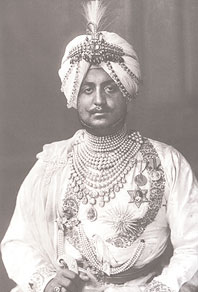
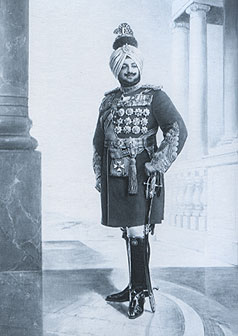
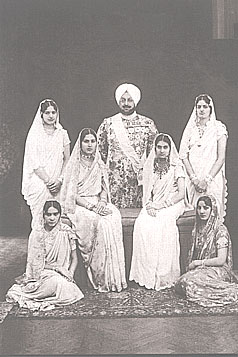
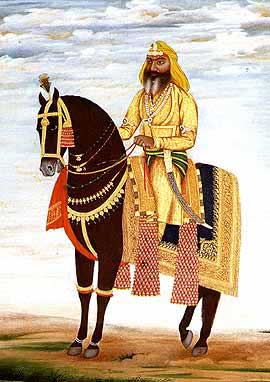
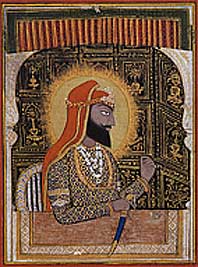
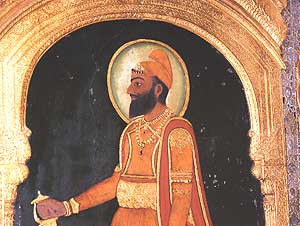
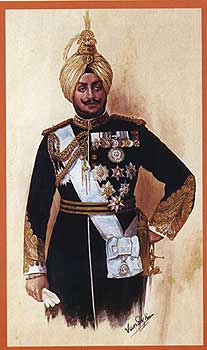
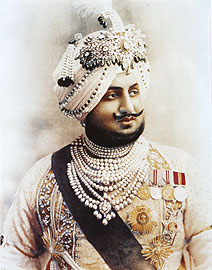

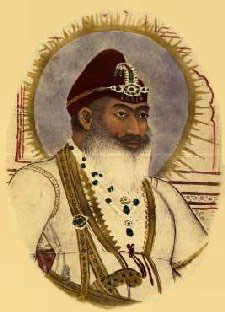
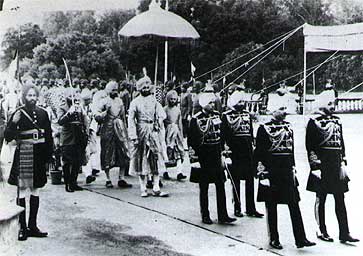
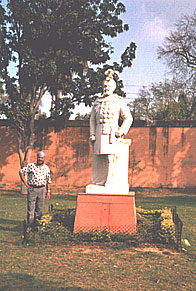
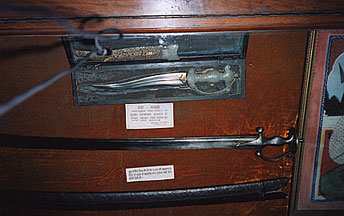
Pesh Kabaz of Guru Gobind Singh Ji and a sword given to him by Yar Mohammed of Surat. These arms are in the Qila Mubarak.(photo kanwal)
There was still considerable evidence of bulk purchasing when Hede Dayal came to Patiala in 1945: 'Once when I was in the music room I found stacks of scores and when I asked Max Geiger, the Viennese conductor of the Patiala orchestra, why this was so, he said, "Well, the old man went to Vienna and I gave him a list of the music I wanted. But they lost the list so he just went to the shop and told them to pack up the whole shop and send it to Patiala".' 'The Patiala toshakhana itself was filled with knick-knacks bought up during various European shopping sprees - tin trunks with layer upon layer of pearls with diamonds, pearls with rubies, pearls with emeralds, jewels for nuths (nose-rings), jewels for the feet, jewels for the belly-button and for God-knows-what. There was so much of it that I found myself incapable of taking in their beauty. It was like costume or stage jewellery.' (courtesy Princes of India)
